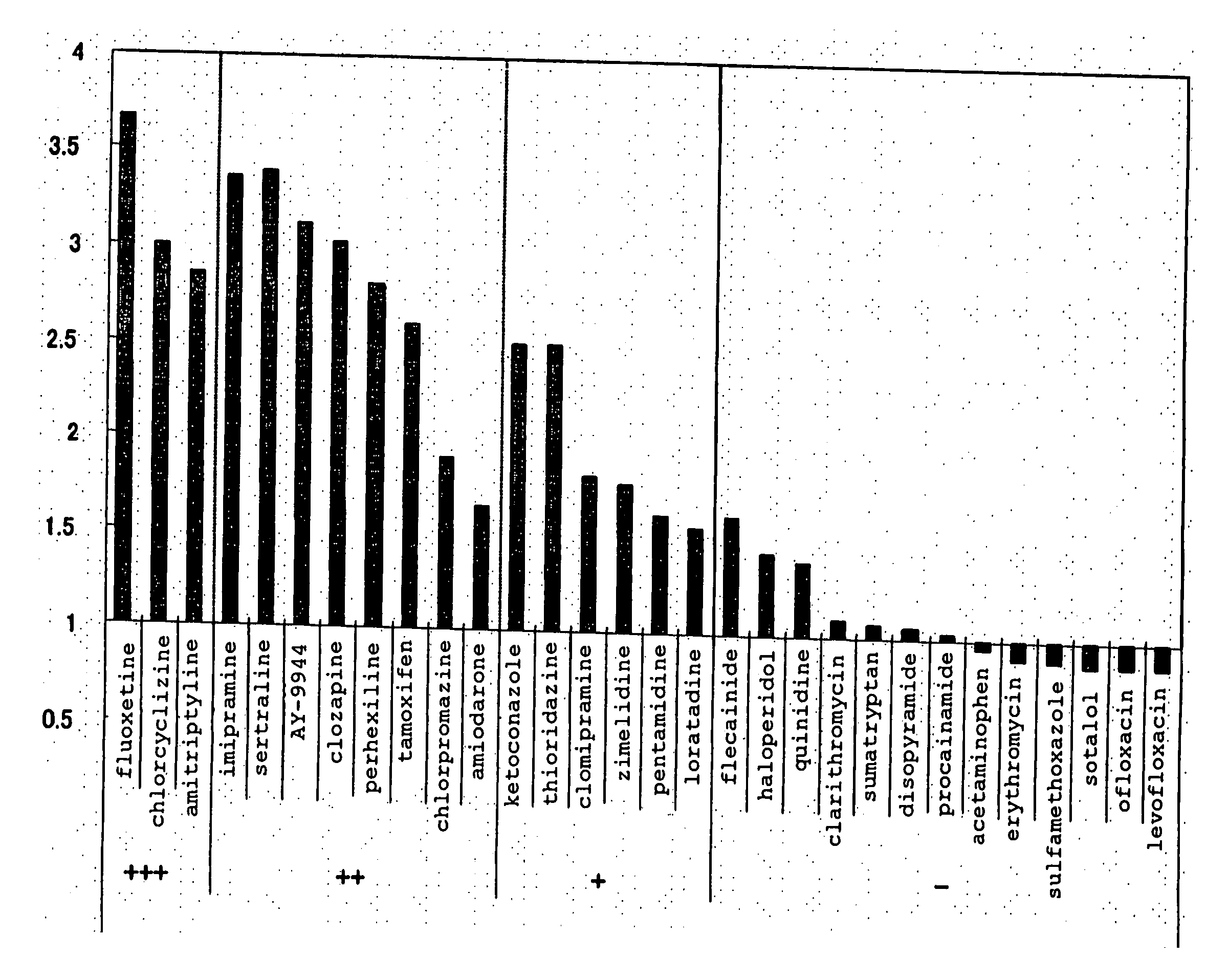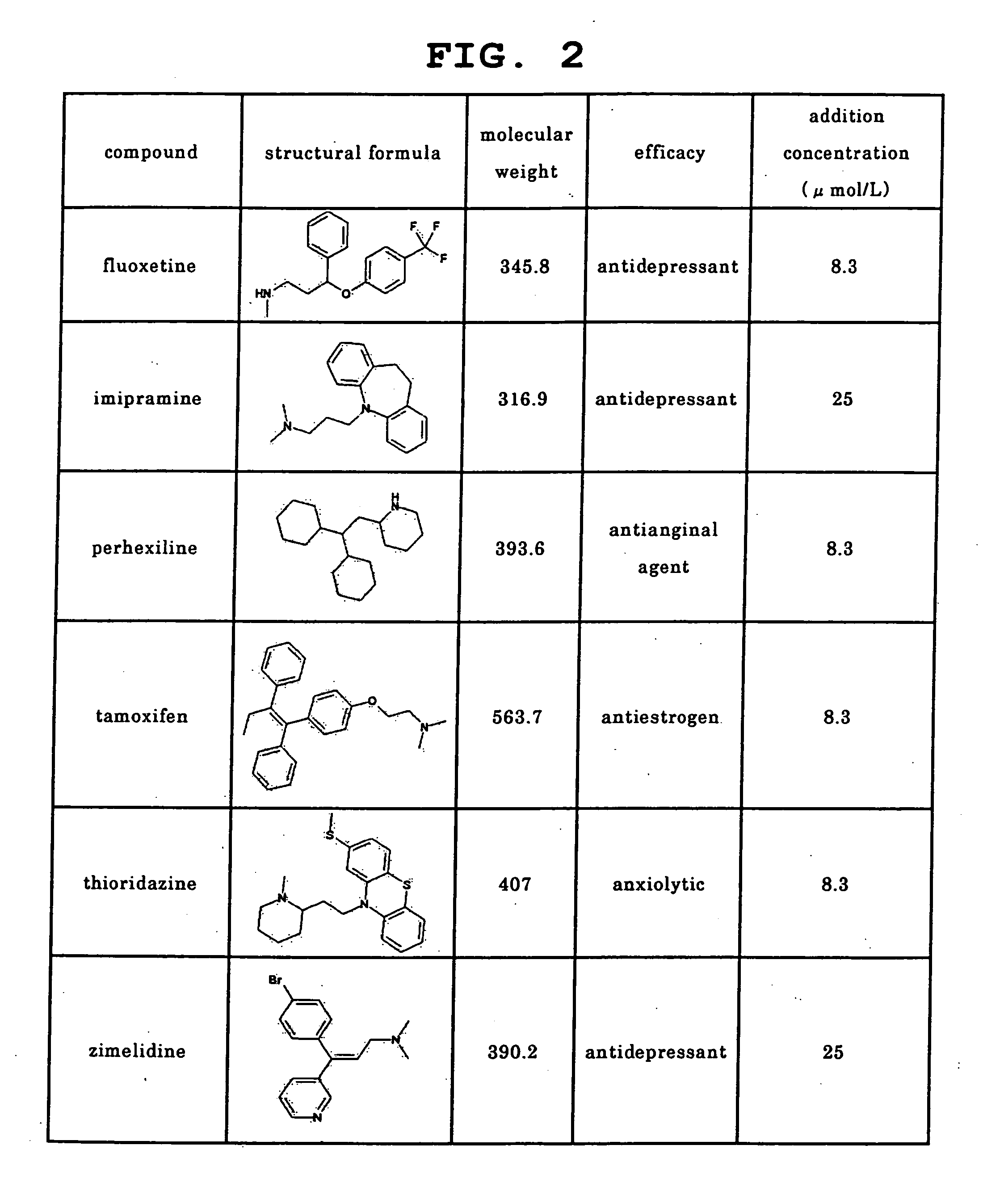Method of Estimating Toxicity of Drug
a toxicity and drug technology, applied in the field of predicting the toxicity of drugs, can solve the problems of insufficient reliability and/or rapid performance, inability to establish a practical in vitro screening system, defective tests, etc., and achieve high expression variation rates and highly reliable in vitro evaluation
- Summary
- Abstract
- Description
- Claims
- Application Information
AI Technical Summary
Benefits of technology
Problems solved by technology
Method used
Image
Examples
example 1
Reference Example
Electromicroscopic Examination of PLsis Induction Potential of Compound
[0140] Using 30 kinds of the following commercially available drugs as test compounds, the level of PLsis induction potential was examined with the emergence of an intracellular myelin-like structure or a structure having a high electron density, which is an early image thereof, as an index by electronmicroscopic observation. Amiodarone and clozapine were purchased from ICN Biomedicals, imipramine, clarithromycin, disopyramide, erythromycin, haloperidol, ketoconazole, quinidine, sertraline and sulfamethoxazole were purchased from Wako Pure Chemical Industries, Ltd., amitriptyline, AY-9944, chlorcyclizine, chlorpromazine, clomipramine, fluoxetine, perhexiline, tamoxifen, thioridazine, zimelidine, acetaminophen, flecainide, ofloxacin and sotalol were purchased from Sigma, levofloxacin was purchased from Apin Chemicals, loratadine and sumatriptan were purchased from KEMPROTEC, pentamidine was pur...
example 2
Expression Variation of Various Genes Due to Exposure to Known PLsis Inducing and Non-Inducing Compounds
[0145] In the same manner as in Example 1 (Reference Example), HepG2 cells were exposed to 17 kinds of PLsis-inducing compounds and 14 kinds of PLsis non-inducing compounds for 24 hr each, the culture medium was removed and the cells were cryopreserved at −80° C. Using RNeasy Mini Kit (QIAGEN), total RNA was purified from the cells, and cDNA was synthesized in a 100 μL system using TaqMan Reverse Transcription Reagents (PE Applied Biosystems).
[0146] Based on the base sequences shown in SEQ ID NOs:1, 3, 5, 7, 9, 11, 13, 15, 17, 19, 21 and 23, primer and FAM labeled-probe were designed using Primer Express (PE Applied Biosystems) and synthesized (committed to SIGMA Genosys Japan).
[0147] The sequences of respective primers and probes are respectively shown in SEQ ID NOs:25-60. As the primer for glyceraldehyde-3-phosphoric acid dehydrogenase (GAPDH) and VIC labeled probe, those at...
example 3
Confirmation of Reliability of Evaluation System
[0151] In the same manner as in Example 1 (Reference Example), HepG2 cells were exposed to 26 kinds of compounds unknown as to the presence or absence of a PLsis induction potential for 24 hr each, and in the same manner as in Example 2, expression variation rate of 12 PLsis marker genes was determined and an average variation rate (each gene was considered to have the same weight) was calculated. The same test was performed twice. The average variation rate of the first test is shown in the x coordinate, the average variation rate of the second test is shown in the y coordinate and the results of each test compound are plotted in FIG. 7. Comparison of the two test results revealed good reproducibility (R=0.907). The presence or absence of emergence of a myelin-like structure upon exposure of HepG2 cells to these 26 compounds for 72 hr was separately detected according to the method of Reference Example, and the relationship with an ...
PUM
| Property | Measurement | Unit |
|---|---|---|
| temperature | aaaaa | aaaaa |
| temperature | aaaaa | aaaaa |
| temperature | aaaaa | aaaaa |
Abstract
Description
Claims
Application Information
 Login to View More
Login to View More - R&D
- Intellectual Property
- Life Sciences
- Materials
- Tech Scout
- Unparalleled Data Quality
- Higher Quality Content
- 60% Fewer Hallucinations
Browse by: Latest US Patents, China's latest patents, Technical Efficacy Thesaurus, Application Domain, Technology Topic, Popular Technical Reports.
© 2025 PatSnap. All rights reserved.Legal|Privacy policy|Modern Slavery Act Transparency Statement|Sitemap|About US| Contact US: help@patsnap.com



